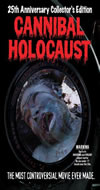 
1980 - 96m.
Italy 
|
In 1980, Italian director Ruggero Deodato made his permanent mark on horror cinema and unleashed upon the world this unforgettable film. Horror fans the world over know it as one of the most controversial movies ever made due to its depictions of real animal violence and some pre-internet folklore that the documentary film crew featured in the movie were really killed. This type of conversation was revisited again in 1999 with a film that borrowed heavily from Deodato's masterpiece in terms of style and execution. That film was another one of my favorite horror movies: The Blair Witch Project.
The premise of Cannibal Holocaust is familiar to us. A film crew goes into a remote area of the Amazon never to be heard from again. A professor named Harold Monroe (Robert Kerman), decides to venture into the jungle to find out what happened to the film crew. The first half of the film follows Monroe as he tries to locate the resident cannibal tribes and eventually attempt to communicate with them. He also finds the film cans that the crew left behind which he promptly brings back to America where the missing filmmakers are big news. A media company in the States is itching to release the footage but as they are screening it, they find out what became of the filmmakers and why. It turns out that they were a group of self-serving scumbags who attempted to exploit and manipulate the natives so that they could get great footage, no matter what the cost. The group's horrible actions backfire on them and we eventually discover what their fates were.
On paper, the plot sounds relatively thin but the way that Deodato shot the neo-documentary footage of the filmmakers is as real as it gets. The best word to describe this film is raw as the two cameras are shooting all over the place but you are sucked right into the world of the filmmakers. The fact that they are always in character and are seemingly operating the cameras themselves is brilliant. Even with all of that going on, we never see any evidence of a real film crew in the vicinity and nothing feels staged unless we are meant to feel that way.
The pacing of this film is also incredibly important in its success. Deadato opens with Riz Ortolani's beautiful theme song over aerial shots of the Amazon and quickly gets us interested in the mystery of the missing filmmakers. When Monroe heads into the jungle, we are unaware of what happened to the crew and are hoping that he will find them somewhere in the jungle. These scenes are great to watch on a second viewing as we see how Monroe follows the trail of the film crew and discovers clues that payoff later when we think back on how they got there. While this first half is merely setting up the latter half, Kerman's portrayal of Monroe keeps us interested as he desperately tries to communicate with the various tribes. By the time we start to watch the film crew's footage, Deodato has a firm grip on us and then proceeds to squeeze for the rest of the film resulting in a truly breathtaking experience.
Now, I can't finish this review without giving somewhat of a disclaimer regarding the content. This is some intense and disturbing stuff and the second half is an atrocity exhibition that includes female and male genital mutilation, a baby ripped from the womb, rotting corpses, rape, impalement, amputation, and graphic scenes of bodies being torn apart and eaten. In addition to all of this, there is the aforementioned animal violence including a muskrat, a turtle (which even I had to close my eyes through), a spider, a snake, a monkey, and a pig. If you are even remotely squeamish, you will have a difficult time getting though these scenes. From a moral perspective, these scenes are reprehensible and are likely to offend even those viewers who think they have 'seen it all'. Deodato claims to regret these scenes but they are obviously a part of why the film has the reputation it has. I know that the recent DVD release from Grindhouse has an animal-cruelty free version that will likely not have quite the same impact as the version with the violence. The fact is that these scenes made dislike the characters as much as was intended and I can also see how having these scenes could have added to the confusion regarding whether all of the footage was real. Needless to say, the film will elicit a reaction from you and is likely to offend pretty much everybody.
What is interesting about the whole thing is that although the movie contains many scenes of violence and degradation, it is still treated like a proper film with meticulous attention being paid to the characters, the plot, and a social commentary on the media. At the end of the day, this is an unforgettable experience that you will remember for the rest of your days whether you love it or hate it. Not many films can claim that.
Star Robert Kerman was also a well-known porn star who is best known for being the guy who has sex with the title character in Debbie Does Dallas. The blonde documentary crew member, Jack, was played by Perry Pirkanen who had brief roles in Cannibal Ferox and City Of The Living Dead. Mario Bava's son, Lamberto, was an assistant director. (Josh Pasnak, 12/16/05)
Directed By: Ruggero Deodato.
Written By: Gianfranco Clerici.
Starring: Robert Kerman, Gabriel Yorke, Francesca Ciardi, Perry Pirkanen.
|